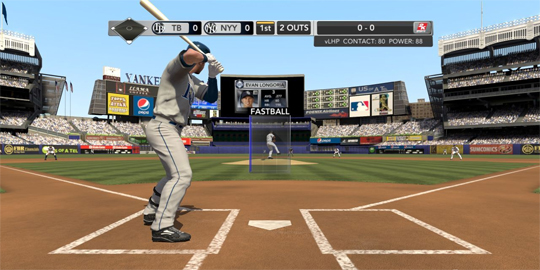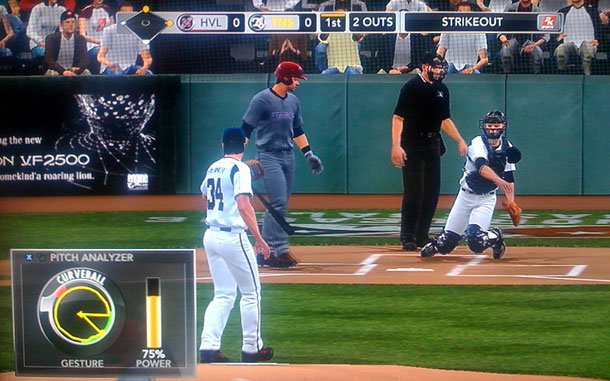Developing a great videogame simulation of one of the world’s most complex professional sports is not as easy as one might think, as evidenced by the numerous baseball titles that have seen ho-hum critical reception throughout the years. For the franchise’s tenth anniversary, Visual Concepts and 2K Sports have set out to rectify whatever failings MLB 2K games have suffered from in the past with an overhauled product, and one that succeeds in bringing the series back to relevance.
Maybe the most important aspect of any baseball videogame is making the player feel that they are actually involved in America’s national pastime, and thanks primarily to its pitching and batting interfaces and new “My Player” mode, MLB 2K10 does this just as well or better than any game out there. While baseball games have traditionally been very much about cursor alignment, meters, and other input mechanisms that constantly remind players that what they are doing is artificial, MLB 2K10 simplifies its core gameplay in such a way that players still have a high degree of control and influence over what is happening on screen without separating them from the experience.
Pitching and batting are both controlled with gestures on the right analog stick. Pitches are performed via two-step motions, such as back/forward, forward/quarter-circle, right/semicircle, etc. These determine both speed and accuracy while keeping players’ eyes in the strike zone at all times, where a simple expanding circle indicates proper timing, with “weak” and “overthrow” penalties for early or late input and wild pitches resulting from completely botched motions. This is one of the few baseball games that makes pitching actually enjoyable as you work the batter with an arsenal of differing weapons.

Batting has further eliminated on-screen overlays, and is instead based primarily on timing and analog motion. Tapping the right stick forward executes a normal swing, while pulling back prior to the forward swing takes a heftier power cut. This extra motion works just as one might expect, providing great rewards, but making it far more difficult to meet the game’s strict timing requirements. In fact, although it appears to be simple, what’s under the hood of the batting system makes for a much more realistic battle between offense and defense, effectively tempering the slug-fest of the juiced-ball era of virtual baseball. An excellent addition this year, and something baseball players will definitely appreciate, is the defensive swing. This lets players fight off close pitches and work the count just as they would in a real batter’s box, in hopes of getting a better pitch to hit on the next delivery, or perhaps drawing a walk. Patience pays off in MLB 2K10; players can actually draw those walks by paying attention to each pitch and exercising some discipline. The game’s highly customizable camera, which lets each player view the action from the perspective best for him (about 300 variations from the plate alone!), further demonstrates 2K’s efforts to get this pitcher-batter battle just right. Somehow, though, the development team managed one unbelievable failure in this department by completely omitting check swings. There’s absolutely no excuse for that, especially considering the precision with which the game is able to detect pitching motions..
Overall baserunning control is excellent, allowing the player to toggle runners easily and direct them to the appropriate base no matter where they are on the basepath. Hit a sure double and you can immediately direct the batter to second or send a runner home by highlighting the appropriate on-screen blip and moving the right stick in the direction of the base. Another feature, along with the defensive swing, that should have been included in baseball videogames ages ago, is the display of 1, 2, 3, or H on each runner icon to indicate their intended destinations. Stealing is a bit trickier, mostly because the game does a poor job of explaining its controls, but also because pitchers seem to have a touch of clairvoyance going on and will pick runners off like it’s their job (because, well, it is). Without impeccable timing or Olympic runners, players are often caught in rundowns, which are not the game’s forte; it’s way too easy to reach base safely in such situations. A runner should rarely get out of a pickle like they so regularly do in MLB 2K10, especially at the major league level.
There is far more to any baseball videogame than just its core mechanics. The bottom line for most players is the quality of the complete package. Features and presentation, statistical and managerial depth, and, as the genre evolves, individual player career modes are all imperative. On top of home run derby, franchise, postseason, drill, and roster management modes, MLB 2K10 adds the “My Player” mode this year to satisfy the needs of baseball role-players, and it is one of the most enjoyable aspects of the game.
In My Player mode, a custom-created ballplayer is brought up through the minors and into the bigs by performing his individual duties on a double-A ball club in a MLB team’s farm system. The player hits, runs, pitches (if applicable), and plays the field only during the plays that involve him, and earns points by completing certain goals set by the game and for generally good performance on the field. These are divided into specific batting, running, pitching, and fielding categories and are used to increase ratings that fall under those headings. Once certain goals are met, it’s up to the majors, and later, hopefully, into the Hall of Fame after a lengthy, multi-season career. Throughout, the pressure of each appearance is always a heavy, “do-or-die” feeling, because you’ll only have a few opportunities to perform per game.
The whole experience is quite captivating, although sometimes the prescribed goals are sometimes at odds with what is actually best in a particular situation, like when “get ahead in the count” leads you to watch a pair of strikes before marking “K” in the books. In such instances, the choices are to ignore the goals or possibly hurt your performance in an attempt to achieve them. The other big problem is in the point allocation itself. Because a player can only earn baserunning points by actually running the bases, a speedy, base-stealing type must also be a threat at the plate in order to ever have the opportunity to improve his running. The game needs some sort of fleshed-out training option to significantly improve stats aside from the occasional drill day, because diverse player specialization suffers without it.

Another major area of interest is the game’s Franchise mode, which functions exactly as one might expect, managing a ball club through multiple pre-, post-, and regular-season campaigns while managing every aspect of the franchise. The player can be as involved or uninvolved as he would like, choosing to manually manage, automate, or ignore nearly every aspect of the game, including major and minor league rosters, trades and injuries, call-ups and send-downs, player contracts and franchise staff, and special inside edge scouting reports that can be purchased for individual teams in the league. Involvement in matters far on the business end — managing parks, marketing, and injury rehab — are not included, as in MLB 10: The Show. Games themselves can be played or simulated, or a combination of both, with the jump-in, jump-out Super Sim option. Worth noting here is the menu system and organization, which is unnecessarily obfuscated and labyrinthine throughout MLB 2K10, potentially confusing players or preventing them from taking advantage of all aspects of the game. It is at the same time conveniently integrated into every part of the game, however, available no matter what the player is doing.
MLB 2K10‘s presentation, in general, has its strong and weak points. The game’s visuals are a step up from last year’s offering from 2K, but are still notably aliased, still lack detail in some areas, and are certainly inferior to competitor Sony’s product. Occasional clipping and misplaced runners detract from the mostly impressive broadcast-style presentation, and although fielding controls are smooth and manageable this year, animations in between the lines are often more awkward than you’d hope to see in the majors. Conversely, MLB 2K10‘s commentary and soundtrack are both excellent, with great background tracks and Gary Thorne, Steve Phillips, and John Kruk talking about everything but the players’ latest bowel movements during games. Occasionally, though, the guys in the broadcast booth speak inaccurately about the action (like saying a player kept the ball himself when he really flipped it to another player), and all audio tends to hiccup during save and load operations, which can be minimized by playing from the Xbox 360 hard drive.
MLB 2K10 does a great job of making players feel as though they’re playing baseball, rather than watching a telecast or playing a videogame. It falls short of its competitors in visual presentation and overall depth, but gets the most important aspects of core gameplay and immersion just right.

















